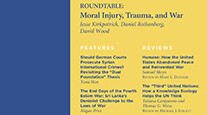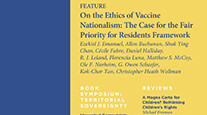In The Purpose of Intervention, Martha Finnemore probes how shifts in the international normative context have shaped state action, even in an area where conventional accounts about the role of power and material interests would seem to prevail. More broadly, The Purpose of Intervention sheds light on the ways in which both international society and its conceptions of the legitimate use of force have evolved historically. This concise book is intended for a wide audience, including those interested in security studies, constructivism, and legal scholarship, as well as normative theory and ethics.
Historically, Finnemore claims, the normative value of using force has eroded steadily. Not only are states more reluctant to declare war, but intervention today tends to be multilateral. In a parallel historical and global trend, she shows that the use of force by states has become increasingly legalized. This diffusion of Weberian rational-legal authority, predicted by a "world polity" approach, has enhanced the role of international law and organizations in defining state interests vis-a-vis the use of force.
In separate chapters, The Purpose of Intervention surveys three cases of systemic change: intervention to collect sovereign debts, humanitarian military intervention, and intervention to protect international peace and order. The author's goal is not to examine individual episodes of intervention per se, but rather to illuminate changes in global patterns of intervention. For example, in a chapter on humanitarian military intervention, echoing her earlier work in The Culture of National Security (1996), Finnemore traces how notions of humanity have become increasingly universalized in intervention practices.
In perhaps the book's most compelling case, Finnemore examines why states stopped using force to collect foreign debts early in the twentieth century. This shift is puzzling since it cannot be explained by conventional factors like changes in technology or state power. In fact, she asserts, the practice of collecting foreign debts ended just as foreign direct investment was expanding. How did the predominantly weak states opposing intervention change the interests of their powerful counterparts? The answer, for Finnemore, lies in the rise of international law as a profession, including the growing prominence of lawyers within diplomatic offices. In a fascinating account, she documents this process and carefully counters alternative explanations.
The book's final case focuses on how different conceptions of order have produced varying patterns of intervention. Turning conventional wisdom on its head, Finnemore argues that even "what the distribution of power is at any given time" is not necessarily obvious (p. 89). Consequently, "what made 1815 a concert and 1950 a cold war was not the material distribution of capabilities but the shared meanings and interpretations participants imposed on those capabilities" (p. 94). The meaning of prevailing international orders (for example, balance of power, concert, or spheres of influence) can therefore change over time. Finnemore proceeds to use quantitative data to measure state power systematically, arguing that the order created after the settlement of Vienna in 1815, though widely considered a multi-polar system, may actually have been a hegemonic or bipolar world. Why, then, did states act as if they were operating under multi-polarity? The author suggests that different understandings of order have affected states' willingness to intervene, including the current reluctance to change territorial boundaries forcibly.
Like other constructivists, Finnemore does not take state motivations or interests as given. Rather, by situating taken-for-granted practices in their broader historical context, she reveals their origins and significance. She also contends that changing beliefs about the use of force can have a constitutive -- not merely regulative -- effect, insofar as they recast an actor's interests. Nonetheless, for Finnemore the battle is not between norms and beliefs on the one hand and power and interest on the other. She admits that power matters, and that it may even be necessary to change state practice, though it is rarely sufficient. Following her earlier work, she also takes political contestation seriously in problematizing the subject of intervention. Intervention, after all, contravenes basic principles of state sovereignty and self-determination. In treating intervention as a contested and fluid state practice, she remains acutely aware of human agency, especially the potentially transformative role of persuasion and debate. Accordingly, she relies on both discourse and behavior to identify shifts in state practice.
In the concluding chapter, Finnemore generates hypotheses about the conditions under which social purpose can change. She outlines a taxonomy of such mechanisms, at both the collective and individual levels. Collectively, she points to the role of coercion; international institutions and law; professions and epistemic communities; as well as social movements. Individually, she highlights the significance of persuasion and communicative action; affective mechanisms (i.e., liking and empathy); social influence and internalization. The author identifies these mechanisms inductively from the book's cases and deductively from an interdisciplinary body of research.
The Purpose of Intervention is subject to a few relatively minor criticisms. First, some readers might object to Finnemore's coding of cases of intervention, which has three components: states must use the term "intervention" to refer to their activities; military force must be used; and the use of force must be opposed. Making opposition part of the definition of intervention may be problematic conceptually, as it blurs the line between the practice of intervention and the process of contestation. Second, the historical sweep of the cases dealing with humanitarian intervention and international order is partly offset by the difficulty of tracing thoroughly the impact of beliefs on state practice across centuries (and of controlling for alternative explanations). Third, the mechanisms outlined in the concluding chapter perhaps should have been placed earlier in the book, with the final chapter venturing to address the conditions under which various mechanisms alter social purpose.
Anticipating these potential criticisms, Finnemore is modest in her goals for the book. The Purpose of Intervention aims to describe how changing beliefs have influenced states' willingness to intervene forcibly in other states, and it seeks to generate a set of hypotheses about the processes by which social purpose can evolve in world politics. But while the objective is not one of theory-testing, the result is no less impressive, as the author succeeds in challenging conventional views of the use of force and advancing research on international norms and social purpose. The breadth of evidence and theoretical innovation make this an important book worthy of wide attention.
--Sonia Cardenas, Trinity College



